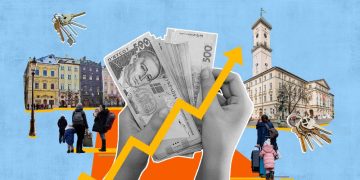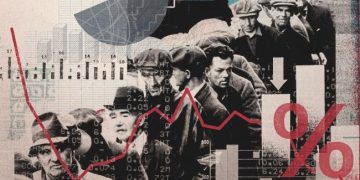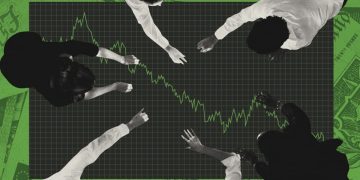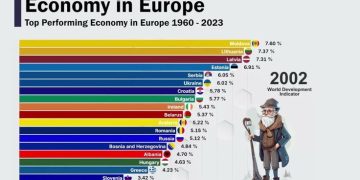Introduction: A Currency in Crisis
The ascendance of Donald Trump to the presidency of the United States marked a significant turning point, propelling the dollar to new heights. In stark contrast, the euro—another currency emblematic of a developed economy—now faces intensified downward pressures. As of November 26, despite a retreat in the dollar index to around 106, the euro concluded the trading day with losses against the dollar, demonstrating a marked fatigue. The ongoing struggles of the euro can be largely attributed to the dual challenges of a robust dollar and the stagnant economic landscape of the Eurozone, compounded by the European Central Bank’s (ECB) monetary policy.
Monetary Policy Decisions: A Double-Edged Sword
In the current cycle of rate reductions, the ECB has taken the lead, initiating cuts before the U.S. Federal Reserve. During the October monetary policy meeting, the ECB announced a 25 basis point reduction in the deposit mechanism rate, main refinancing rate, and marginal lending rate. At present, ECB President Christine Lagarde has offered no clear indications regarding future policy moves; however, as inflation levels in the Eurozone diminish, it is highly probable that the bank will continue its descent into lower rates.
Market participants are increasingly concerned about the potential repercussions of another Trump presidency, particularly regarding economic policies that could reignite inflation in the U.S. Such fears fuel speculation that the Federal Reserve may slow its rate-cutting trajectory next year, providing further upward support for the dollar. Should the ECB persist in cutting rates in this context, the euro may find itself caught in a vice, with its weaknesses exacerbated.

Inflationary Pressures: A Mixed Bag
The recent uptick in the Eurozone’s inflation, as reported by Eurostat, paints a complex picture. The Harmonised Index of Consumer Prices (HICP) for October showed a year-on-year growth of 2%, surpassing September’s 1.7%. Moreover, on a month-to-month basis, October’s HICP rose by 0.3%, in stark contrast to a 0.1% decline in September. When volatile food and energy prices are stripped away, the core inflation rate remained at 2.7%, slightly above the anticipated 2.6%.
This rebound in inflation suggests a potential recovery in the coming months. Yet, the continued movement towards the ECB’s 2% inflation target could bolster the case for further rate cuts. ECB Vice President Luis de Guindos has pointed out that recent data indicates inflation could align with the intended target, implying that upcoming policy adjustments are on the horizon. If inflation effectively converges on this target, it would compel the ECB to recalibrate its monetary policy responsively.
Economic Stability: Lacking in Support
Beyond monetary policy, the Eurozone’s economic fundamentals seem insufficient to provide robust support for the euro. Recent data reveal that in the third quarter of 2024, seasonally adjusted GDP grew only by 0.4%. The European Commission projects a mere 0.8% growth for 2024, with subsequent growth rates of 1.3% and 1.6% anticipated in 2025 and 2026 respectively.
The Commission has cautioned that uncertainties and downward risks in the economic outlook have markedly increased. Contributing factors include the Russia-Ukraine conflict, escalating geopolitical tensions in the Middle East, protectionist measures from key trade partners that could disrupt global trade, and internal policy uncertainties within Europe—each posing a threat to competitiveness. Furthermore, the rising frequency and scope of natural disasters are increasingly impacting economic stability.
Manufacturing: A Sector in Decline
Manufacturing in the Eurozone continues to contract, with the purchasing managers’ index (PMI) for October recording a final value of 46. Although this represents a slight increase from the initial estimate of 45.9 and the September final of 45.0, it marks the 28th consecutive month of decline for the sector. The performance of the Eurozone’s two largest economies in manufacturing is similarly troublesome. Germany’s October PMI stood at 43.0, marginally above September’s 40.6 but still below the critical 50 threshold. France’s October PMI also fell to 44.5, down from 44.6 in September.
Conclusion: The Euro’s Future Amidst Uncertainty
The current landscape illustrates that the Eurozone’s wobbly economy, coupled with the ECB’s accommodative monetary stance, significantly weighs on the euro. While the ECB’s rate cuts may offer some support for regional economic recovery, de Guindos has emphasized that the ECB alone cannot revitalize the economy. Structural challenges at the core of the Eurozone’s economic malaise require attention, and should the dollar maintain its strength, the euro’s outlook remains fraught with risk.
Importantly, the EU and the ECB must brace for the potential challenges stemming from the Trump administration’s policies next year. Although forecasts indicate a rebound in economic growth for the Eurozone in 2025 and 2026 alongside continued inflation decline, the Commission has warned that the protectionist trade policies under a Trump-led government could pose significant threats to Europe. Additionally, ECB officials have expressed concerns over the vicious cycle that a trade war might instigate, further burdening an already feeble economy.
As we stand at this crossroads, the euro finds itself grappling with intensified downward pressures amid both internal strife and external threats. Fears of a repeat of two years ago—when the euro faltered against the dollar—linger. In that tumultuous period, aggressive rate hikes by the Federal Reserve and a strengthening dollar conspired to push the euro below parity with the dollar multiple times.
Nevertheless, the euro persists in its endeavor to hold firm. Its future direction against the dollar will hinge not only on the effectiveness of the Eurozone’s monetary policies and economic performance but also on the evolving landscape of the dollar—particularly under the economic policies enacted following Trump’s return to the presidency.































